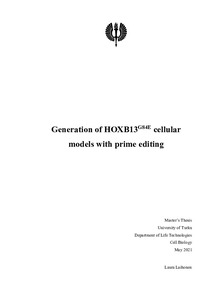Generation of HOXB13G84E cellular models with prime editing
Laihonen, Laura (2021-05-07)
Generation of HOXB13G84E cellular models with prime editing
Laihonen, Laura
(07.05.2021)
Julkaisu on tekijänoikeussäännösten alainen. Teosta voi lukea ja tulostaa henkilökohtaista käyttöä varten. Käyttö kaupallisiin tarkoituksiin on kielletty.
avoin
Julkaisun pysyvä osoite on:
https://urn.fi/URN:NBN:fi-fe2021052431323
https://urn.fi/URN:NBN:fi-fe2021052431323
Tiivistelmä
Prostate cancer (PCa) is the second most common cancer in men and the fifth leading cause of cancer-related death in men. PCa is a highly heritable disease and genetic factors explain 58 % of the risk. Studies on PCa have led to identification of germline mutations associatedwith PCa, and the G84E mutation in HOXB13 is one of these identified mutations. This germline mutation was identified almost a decade ago in 2012, however, its function and mechanism in PCa progression remain elusive. Prime editing is a novel genome editing method where new genetic information is added into a specific DNA site with the prime editor (PE) containing catalytically impaired Cas9 endonuclease fused to reverse transcriptase (RT) and green fluorescent protein (GFP). An additional prime editing guide RNA (pegRNA) contains the template with the desired edit and targets the PE to the specific site in the genome.The aim of the thesis was to generate the G84E mutation in HOXB13 with prime editing. Three different pegRNAs with different lengths of primer binding sites (PBS) were generated to see which is the most efficient. Single guide RNA (sgRNA) was used to nick the non-edited strand which favors the DNA repair of the non-edited strand forcing the cells to use the newly PE edited strand as a template. Protein lysates of PCa cell lines were prepared and analyzed with Western blot to see if they express HOXB13. LNCaP cells expressing HOXB13 were transfected with plasmid constructs and GFP-positive cells were sorted. Gene editing efficiency was measuredwith droplet digital PCR (ddPCR).pegRNA with a PBS of 16 nucleotides (nt) worked with approximately 10 % efficiency, but the efficiency of pegRNA with PBS of 13 nt remains unclear. PBS of 10 nt did notwork at all suggesting that it is too short for proper binding to the target DNA. In conclusion, pegRNA with PBS16 can be used to generate HOXB13G84E cellular model for further studies of the mutation to understand its role in PCa progression.
